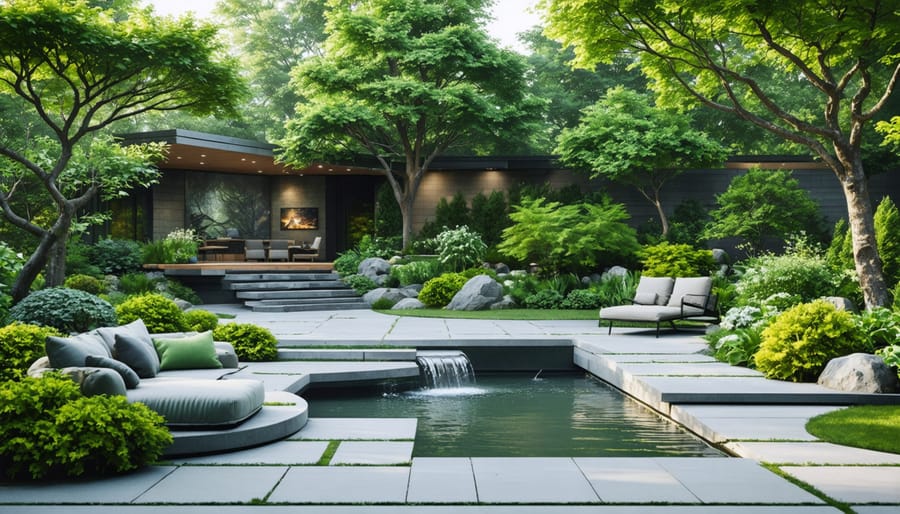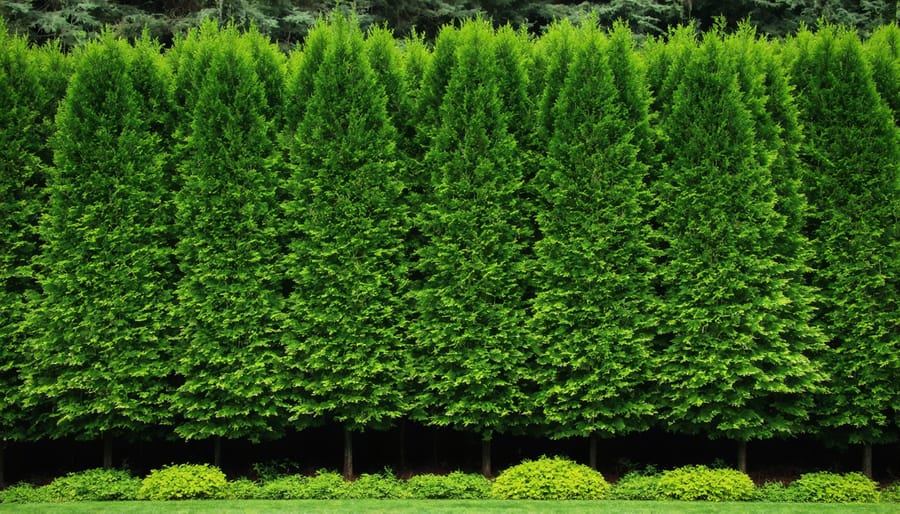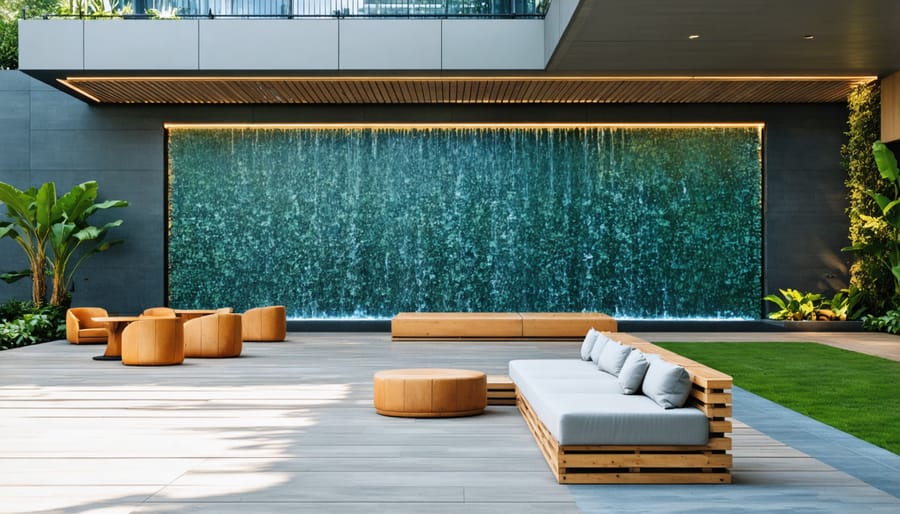Transform Your Noisy Backyard Into a Peaceful Home Office Haven

Transform your backyard into a comfortable outdoor workspace by strategically combining sound-absorbing plants, barriers, and landscaping elements. Plant dense evergreen trees like Leyland Cypress or Italian Cypress in a staggered formation along property lines, creating a natural sound barrier that reduces noise by up to 6-8 decibels. Install a living wall system with climbing vines like English Ivy or Virginia Creeper on existing fences to add mass and sound-dampening properties. Layer your landscape with varying heights of shrubs, ornamental grasses, and ground cover to diffuse sound waves before they reach your work area. Position water features strategically to mask unwanted noise with soothing sounds, while incorporating raised garden beds and berms to redirect and absorb sound waves. These natural solutions not only create a peaceful environment but also enhance your property’s visual appeal and privacy.
Strategic Plant Placement for Maximum Noise Reduction
Best Noise-Blocking Trees and Shrubs
When it comes to creating effective sound barriers, certain trees and shrubs excel at blocking unwanted noise while adding natural beauty to your yard. As part of your eco-friendly outdoor solutions, consider evergreen varieties like Leyland Cypress and Eastern Red Cedar, which provide year-round noise reduction thanks to their dense foliage and thick branches.
Holly trees and shrubs are particularly effective noise blockers, with their tight growth pattern and sturdy leaves creating an excellent sound barrier. The American Holly can grow up to 50 feet tall, making it perfect for blocking noise from second-story windows or distant traffic.
Bamboo offers quick-growing sound reduction, often reaching maturity within just a few years. Its dense clusters of stems and leaves create an effective natural noise barrier while adding an exotic touch to your landscape.
For smaller spaces, consider Viburnum or Juniper shrubs. These versatile plants can be shaped into hedges and maintain their noise-blocking properties throughout the year. Portuguese Laurel is another excellent choice, combining glossy leaves with dense growth patterns that effectively absorb sound waves.
To maximize noise reduction, plant these varieties in multiple rows with staggered spacing. This creates a more effective sound barrier than a single line of plants. Remember to consider your climate zone and maintenance requirements when selecting your noise-blocking greenery.
Creating Dense Plant Barriers
Creating an effective plant barrier requires strategic layering of vegetation at different heights to maximize noise reduction. Start with tall evergreen trees like Leyland Cypress or Italian Cypress as your backdrop, planting them in a staggered pattern to eliminate sound gaps. These trees should be spaced about 6-8 feet apart to allow for mature growth while maintaining a solid barrier.
In front of your tall trees, introduce medium-height shrubs like Viburnum or Holly, which provide dense year-round coverage. Plant these 3-4 feet apart, positioning them between the gaps of your taller trees. This middle layer is crucial for catching sound waves that might slip through the upper canopy.
The final layer should consist of low-growing plants and ground covers. Consider options like Juniper or ornamental grasses, which not only add visual interest but also help absorb sound at ground level. Plant these densely, about 2 feet apart, to create a thick understory.
For maximum effectiveness, aim for a total barrier depth of 6-10 feet. Remember to consider your climate zone when selecting plants, and choose species that naturally grow densely without excessive pruning. Water deeply but infrequently to encourage deep root growth, which helps plants establish a stronger presence and fuller coverage.
Mixed evergreen and deciduous plants can create interest throughout the seasons while maintaining consistent noise reduction capabilities. Just ensure that evergreens make up at least 70% of your barrier to maintain year-round effectiveness.

Hardscape Elements That Reduce Sound
Sound-Absorbing Fences and Walls
When it comes to creating a peaceful backyard environment, solid barriers are among the most effective solutions. Modern sound-absorbing materials have revolutionized fence and wall design, offering both aesthetic appeal and impressive noise reduction capabilities.
Acoustic fencing, typically made from dense composite materials or specially treated wood, can reduce noise levels by 20-30 decibels when properly installed. These fences work best when they’re at least 8 feet tall and have no gaps between panels. For maximum effectiveness, consider installing them close to the noise source rather than near your workspace.
Masonry walls, while more expensive, provide superior sound blocking capabilities. Brick, stone, or concrete walls can reduce noise by up to 40 decibels, making them ideal for areas with heavy traffic or industrial noise. Their durability and low maintenance requirements make them a worthwhile long-term investment.
Living walls combine the benefits of traditional fencing with green elements. These structures feature a solid core wrapped in vegetation, offering both sound absorption and visual appeal. The plant layer adds extra noise reduction while creating a natural, soothing atmosphere.
For those seeking a more budget-friendly option, modular acoustic panels can be attached to existing fences. These panels, often made from recycled materials, are easy to install and can be customized to match your outdoor décor. While not as effective as permanent structures, they can still reduce noise levels by 15-25 decibels.
Remember to check local building codes and HOA regulations before installing any permanent barriers, as height and material restrictions may apply.
Water Features as White Noise Solutions
Water features offer a delightful solution to unwanted noise by creating a soothing, natural sound barrier that masks disruptive urban sounds. The gentle splashing of water not only adds a peaceful ambiance to your outdoor workspace but effectively drowns out everything from traffic noise to neighbor conversations.
When selecting a water feature, consider the volume and type of sound you want to create. Wall fountains produce a gentle, consistent stream that’s perfect for minimal noise masking, while multi-tiered waterfalls create a more robust sound barrier. For maximum effectiveness, position your water feature between your workspace and the primary noise source.
The height of water fall and the surface it lands on greatly influence the sound produced. Water falling onto water creates a softer, more melodic sound, while water hitting stone or metal produces sharper, more pronounced notes. You can fine-tune the sound by adjusting the water flow rate or adding different textures to the landing surface.
Popular options include:
– Cascading rock waterfalls
– Tiered fountain displays
– Wall-mounted water features
– Natural pond systems with small waterfalls
– Self-contained water bowls
Remember to consider maintenance requirements when choosing your water feature. Most systems need regular cleaning and occasional pump maintenance to function properly. During winter months, you’ll need to protect your water feature from freezing, either by winterizing the system or using a heater in milder climates.
The best part about water features is their dual purpose – they not only mask unwanted noise but also add a stunning visual element to your backyard landscape, creating a more inviting and peaceful workspace environment.


Ground Cover and Surface Treatments
Sound-Dampening Materials for Pathways
Creating a quieter pathway system in your backyard starts with choosing the right weather-resistant ground materials that naturally absorb sound. Rubber mulch is an excellent choice for pathways, offering superior sound dampening while providing a soft, bouncy surface that’s comfortable to walk on. This eco-friendly option, made from recycled tires, also stays in place better than traditional mulch and requires minimal maintenance.
Cork pavers present another effective solution, naturally reducing footfall noise while adding a unique aesthetic to your garden paths. These sustainable materials are not only excellent sound absorbers but also provide good traction in wet conditions.
For a more traditional look, consider installing thick grass paths reinforced with permeable pavers. This combination creates a natural sound buffer while maintaining a formal garden appearance. Adding a layer of sand or fine gravel beneath your chosen pathway material can further enhance sound absorption properties.
Remember to maintain consistent ground coverage and replace materials as needed to ensure continued noise reduction effectiveness.
Grass and Alternative Ground Covers
Grass and ground covers play a vital role in sound absorption, making them excellent choices for noise reduction in your backyard. Traditional grass lawns act as natural sound dampeners, absorbing sound waves before they can bounce off harder surfaces. For maximum effectiveness, maintain your lawn at a height of 2-3 inches, which creates a denser sound-absorbing layer.
Consider alternative ground covers that offer even better sound absorption properties. Creeping thyme, sedum, and moss create thick, low-growing carpets that effectively reduce noise reflection while requiring less maintenance than traditional grass. These alternatives also add visual interest and texture to your landscape.
For slopes or areas where grass struggles to grow, consider pachysandra or vinca minor. These hardy ground covers create dense mats that not only reduce noise but also prevent soil erosion. When planning your ground cover strategy, combine different varieties to create layers of sound absorption while maintaining year-round coverage.
Remember to keep your ground covers well-maintained and healthy, as dense, thriving plants are more effective at noise reduction than sparse or struggling vegetation.
Maintaining Your Noise Reduction Landscape
Seasonal Maintenance Tasks
Regular maintenance is crucial for keeping your noise-reducing landscape effective throughout the year. In spring, focus on pruning dense shrubs and evergreens to promote fuller growth, which enhances their sound-blocking capabilities. Check your living walls and vertical gardens for winter damage, and replace any plants that didn’t survive the cold season. This is also the perfect time to add new plants and refresh your mulch layers.
Summer maintenance involves regular watering of sound-blocking hedges and trees, especially during dry spells. Keep grass trimmed around fence bases and maintain climbing vines on trellises or sound barriers. Monitor plant health and treat any pest issues promptly to maintain the density needed for effective noise reduction.
Fall is the time to prepare your noise-reducing landscape for winter. Remove dead branches, secure loose fence panels, and add extra mulch around plants for insulation. Consider wrapping sensitive plants and installing winter protection for living walls. Clean and repair any water features that contribute to masking noise.
Winter tasks focus on protecting your sound barriers from snow and ice damage. Regular inspection of fences and walls helps identify potential issues before they worsen. Clear heavy snow from branches to prevent breakage, and maintain any year-round water features to ensure continuous ambient sound.
Remember to document your maintenance activities and note which strategies work best for your specific situation. This helps you refine your approach and maintain optimal noise reduction throughout the year.
Long-term Care Strategies
To maintain the effectiveness of your noise reduction landscaping, regular maintenance is essential. Start by establishing a seasonal care schedule for your plants and structures. Trim hedges and bushes at least twice a year to maintain their density, as overgrown or sparse vegetation loses its sound-blocking capabilities. For evergreen trees and shrubs, remove dead branches promptly and shape them to preserve their sound-dampening properties.
Water management is crucial for long-term success. Install a reliable irrigation system to ensure consistent growth, especially for living walls and dense hedgerows. During dry periods, deep watering helps maintain healthy root systems, which is essential for plant survival and continued noise reduction effectiveness.
Monitor your hardscape elements regularly. Check fence posts and panels for signs of wear, and address any gaps that may develop over time. For earth berms, inspect for erosion after heavy rains and maintain proper drainage to prevent soil washout. Living walls require particular attention – check the support structure periodically and ensure the irrigation system functions correctly.
Consider applying a fresh layer of mulch annually around your plants. This not only helps with moisture retention and weed control but also provides additional sound absorption. For artificial barriers like fences or walls, schedule annual inspections and repairs, addressing any cracks or damage that could compromise their noise-reducing capabilities.
Creating a peaceful backyard sanctuary through noise reduction landscaping is both achievable and rewarding. By implementing a strategic combination of natural barriers, hardscaping elements, and sound-absorbing plants, you can significantly reduce unwanted noise while enhancing your outdoor space’s beauty and functionality.
Remember that successful noise reduction often requires a layered approach. Start with taller elements like privacy trees or fence panels as your primary sound barrier, then add medium-height shrubs and lower-growing plants to create a comprehensive sound buffer. Water features not only mask unwanted noise but also add a soothing element to your landscape.
The key to success lies in proper planning and maintenance. Consider your specific noise issues, available space, and local climate when selecting plants and materials. While some solutions, like installing a living wall or water feature, may require initial investment, the long-term benefits of a quieter, more enjoyable outdoor space make it worthwhile.
Don’t feel pressured to implement everything at once. Start with one or two strategies and gradually expand your noise reduction landscape over time. Regular maintenance of your chosen elements will ensure their continued effectiveness in creating your peaceful backyard retreat.
By taking action today to reduce outdoor noise, you’re investing in both your property’s value and your daily quality of life. Your backyard can become the tranquil escape you’ve always wanted, perfect for working, relaxing, or simply enjoying the outdoors in peace.

